What is the focal length of the Nikkor AF-S 105 mm f/1.4E ED?
Lately we’ve heard a lot of rumours about the real focal length of the Nikkor AF-S 105 mm f/1.4E ED being closer to 90-95 mm than the officially declared 105 mm. That fact intrigued us so much that we decided to check it out.
Even if you don’t have an access to a professional optical bench, you can compute the focal length of any given lens indirectly, by determining its field of view. When you know that field, along with the respective projection, you can calculate the focal length (f) easily. In the case of the rectilinear projection, common for most of lenses, the formula is as follows:
with S being a focal multiple (for full frame it amounts to 1).
Still if you want to determine the field of view you have to remember one very important issue. The focal length and the field of view stemming from it are stated by the producers for the focus set at infinity. In the case of lenses which shift their inner system of elements during focusing these values change. The colloquial term for such a phenomenon is ‘focus breathing’.
It is very easy to determine the focal length and field of view of a given lens – you just have to take a photo of starry night. Why is it such an excellent idea? For two reasons. Firstly the stars are situated practically in infinity so our parameters can be determined with utmost precision. Secondly, knowing equatorial coordinate system (right ascension and declination) of photographed stars and their coordinates (X, Y) in photos (expressed in pixels) you can transform one system into the other and precisely determine the field of view.
It’s worth mentioning that during the experiment you don’t need any complex tools like an equatorial mount, a device which allows you to compensate for Earth’s rotation so the apparent diurnal motion of the sky. Even in case of longer focal lengths you can choose an area close to the celestial pole (near the Polaris when it comes to our hemisphere) and shorten the exposure time by opening the aperture completely and choosing a higher ISO value.
The proximity of the constellation of Cassiopeia (high declination) and high ISO 3200 allowed us to employ the exposure time of just 3 seconds so the images of stars remained point-like. Their number in the frame is several times too high for our needs anyway so we think even a shorter exposure time of about 0.5-1 second would be quite enough.
By performing the transformation, described earlier, you can find out that the field of view of the photo, presented here, amounts to 23.79 degrees with a quite negligible margin of error of 0.01 of a degree. The producer officially states that the field of view is 23.17 degrees so a tad narrower. That difference might suggest that the focal length of the Nikkor can be actually smaller than 105 mm.
As you already know the field of view you can apply the formula given earlier and determine the focal length (assuming a negligible distortion level). In this case it amounts to 102.3 mm, less than the declared 105 mm but only by 2%. In fact the producers state the focal length with 2-3% of margin of error so there are no reasons to worry. It seems the rumours you can find on the Internet aren’t based on real facts and measurements.
Still it doesn’t mean the Nikkor’s focal length is not shorter when you take a photo from closer distances, a pretty normal thing stemming from laws of physics. A lens which optical system shifts internal elements during focusing has to change the focal length and field of view as well.







